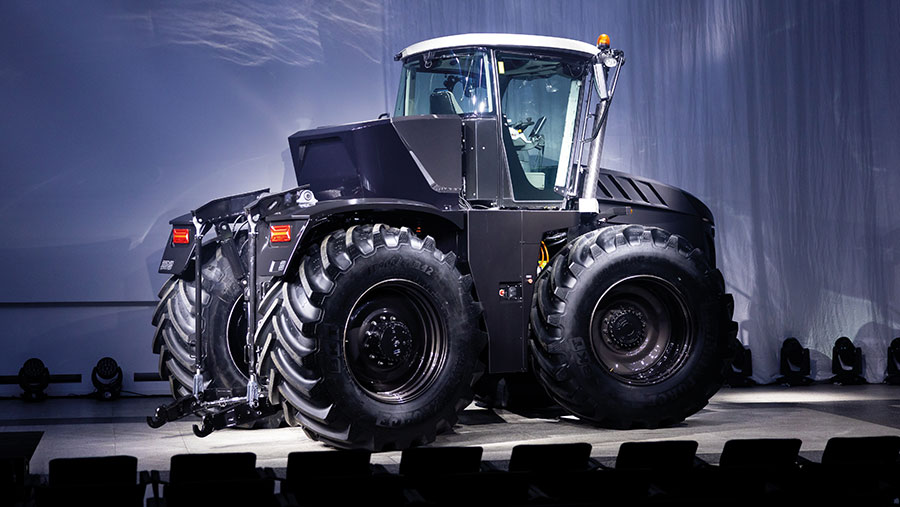Trailblazing Auga M1 methane-electric tractor set for launch
 Auga M1 pre-production © Auga
Auga M1 pre-production © Auga An ambitious project to manufacture a biomethane-fuelled high-performance tractor has moved a step forwards with the unveiling of a pre-production design set for final testing prior to commercial launch.
The Auga M1 is a four-wheel-drive machine with equal-sized wheels all round intended mainly for tillage and drilling or planting work on arable and large-scale horticultural enterprises.
Biomethane harvested from livestock farms provides the fuel for a modest automotive engine and generator producing power to run a trio of electric motors.
One drives the front axle through a gearbox and two at the rear are in the form of hub motors. Any excess power generated is stored in a battery pack located behind the cab.
No power outputs have been detailed so far, but engineers working on the project say the M1 can do the work of a 400hp diesel-engined tractor.
See also: Cornish firm creates kit to turn slurry emissions into fuel
Fuel storage
The principal novelty is the way the fuel is stored in half-a-dozen relatively large cylinders arranged in a cartridge-like assembly positioned within the structure of the tractor where the gearbox and rear axle would normally be.
Depending on workload, each set of cylinders is said to hold enough biomethane for up to 12 hours’ operation.
When empty, the cylinders are disconnected and ejected through the back of the tractor on a hydraulic rack ready to be replaced by a full set.
Kestutis Juscious, CEO of Auga, a large-scale agribusiness based in Lithuania, says the main objectives of the project were to build a power unit with more run time than other gas-fuelled tractors and to come up with a practical refuelling process.
“We’ve solved both problems by offering a quick and convenient gas cartridge replacement system, with cylinders filled at the biomethane plant, not on the tractor, and delivered to each farm,” he says.
“This will eliminate the need for biomethane refuelling stations on farms.”
Limitations
However, this solution does impose some significant compromises.
The large tractor, measuring 6m long and 4m high, has front-axle steering only and a limited steering angle on the 900mm-wide tyres, proposed to provide plenty of traction while minimising soil compaction.
And there is no rear pto as the backplate of the chassis folds down hydraulically to allow the gas cylinder cartridge to be swapped.
Implement operation is therefore limited to non-powered trailed or mounted equipment unless an alternative solution is devised such as implement-mounted drive motors.
Nonetheless, the Auga M1 looks a valiant effort to create a zero-emissions tractor with strong performance potential, and the pre-production machines certainly look the part in terms of styling, the anthracite colour scheme and use of the familiar Claas cab.
Since revealing the concept-proving prototype a year ago, the project’s engineers say they have reduced energy losses, improved the overall efficiency of the electric drive system, and reduced the machine’s weight.
Three pre-production examples have now been built for a project costing €3m (£2.7m) to date, each using a number of different components for final testing, with a view to series production getting under way by the end of this year.
About Auga
Lithuania-based Auga Group claims to be the largest vertically integrated organic food producer in Europe, managing about 39,000ha of organically certified farmland and employing more than 1,200 people.
It specialises in field crops, mushrooms, dairy and poultry, while also producing organic commodities and a range of organic foodstuffs.
In addition to the biomethane tractor, the group is working on reducing emissions from livestock and other agricultural operations.

